Gender, Sustainability, and Urbanism: A Systematic Review of Literature and Cross-Cluster Analysis
Abstract
:1. Introduction
2. Literature Review
Previous Empirical Studies
- What is the general bibliometric outlook on gender equality, urbanism, and sustainability?
- What are the research patterns of publications on gender equality, urbanism, and sustainability?
3. Methodology
3.1. Research Design
3.2. Software Used for Data Analysis
4. Findings and Discussion
4.1. General Bibliometric Outlook
4.2. Keyword Analysis
4.3. Social Network Analysis
4.3.1. Gender Diversity, Corporate Sustainability, and Board Governance (See the Connection of Nodes and Paths in Figure 8 and the Distances between Keywords for Corporate Sustainability, Board Gender Diversity, Board Gender, Corporate Board, Board, Gender Participation, Governance in t-Sne Analysis in Figure 7)
4.3.2. Gender, Environmental Sustainability, Sustainable Development, and Policy Agenda (See the Connection of Nodes and Paths in Figure 8 and the Distances between Keywords for Environmental Sustainability, Gender, Gender Equality, Environment, Agenda, Sustainable Development Goals, Corporate Social Responsibility, Corporate Sustainability in t-Sne Analysis in Figure 7)
4.3.3. Gender, Sustainable Urbanism, and Community Development (See the Connection of Nodes and Paths in Figure 8 and the Distances between Keywords for Woman, Community, Participation, Access, Region, Land, Resource, Gender Empowerment, Female Entrepreneurship, Sustainable Development in t-SNE Analysis in Figure 7)
5. Conclusions and Implications
- Investigating strategies that enhance women’s safety in public spaces, promote inclusive transportation infrastructure, and ensure women’s participation in decision-making processes;
- Exploring the role of technology and innovation in advancing gender-inclusive urban design, the impact of cultural factors on gender-sensitive planning, and the socioeconomic implications of gender-equitable urban spaces;
- Examining how organizations and governments can collaborate to integrate gender perspectives into broader sustainable development policies and can offer practical insights into driving more comprehensive, inclusive, and impactful sustainability initiatives;
- Determining the role of gender in shaping sustainable consumption patterns, the dynamics between gender equality and climate action, and the influence of gender-sensitive policies on promoting environmental resilience;
- Exploring the specific strategies that foster resource efficiency, the role of leadership, and gender diversity in driving innovation for sustainable practices, and the relationship between corporate culture and gender-sensitive governance.
Supplementary Materials
Author Contributions
Funding
Institutional Review Board Statement
Informed Consent Statement
Data Availability Statement
Conflicts of Interest
References
- Mehta, V. Evaluating Public Space. J. Urban Des. 2014, 19, 53–88. [Google Scholar] [CrossRef]
- Warner, M.E.; Zhang, X. Planning Communities for All Ages. J. Plan. Educ. Res. 2022, 42, 554–555. [Google Scholar] [CrossRef]
- Sheila, R.F.; Iaione, C. Ostrom in the city: Design principles and practices for the urban commons. In Routledge Handbook of the Study of the Commons; Routledge: London, UK, 2019; pp. 235–255. [Google Scholar]
- Fitzgerald, K.G.; Caro, F.G. An Overview of Age-Friendly Cities and Communities Around the World. J. Aging Soc. Policy 2014, 26, 1–18. [Google Scholar] [CrossRef] [PubMed]
- Pozoukidou, G.; Chatziyiannaki, Z. 15-Minute City: Decomposing the New Urban Planning Eutopia. Sustainability 2021, 13, 928. [Google Scholar] [CrossRef]
- Odbert, C.; Mulligan, J.; Jewell, R.; Ohler, S.; Elachi, L.; Kiani, N.; Rempe, S. Handbook for Gender-Inclusive Urban Planning Design; The World Bank: Washington, DC, USA, 2020. [Google Scholar]
- De Simone, L. Gender-conscious urbanism and urban planning. In Gender Equality; Filho, W.L., Azul, A.M., Brandli, L., Lange Salvia, A., Wall, T., Eds.; Encyclopedia of the UN Sustainable Development Goals; Springer: Cham, Switzerland, 2020; pp. 1–10. ISBN 978-3-319-70060-1. [Google Scholar]
- Issa, A. Shaping a sustainable future: The impact of board gender diversity on clean energy use and the moderating tole of environmental, social and governance controversies. Corp. Soc. Responsib. Environ. 2023. early view. [Google Scholar] [CrossRef]
- Apostu, S.A.; Panait, M.; Gigauri, I.; Blessinger, P. Exploring the relationship between the urbanization, higher education and female labor force with sustainable development. J. Appl. Res. High. Educ. 2023. ahead of print. [Google Scholar] [CrossRef]
- UN Economic and Social Affairs. World Urbanization Prospects: The 2018 Revision. Available online: https://population.un.org/wup/publications/Files/WUP2018-KeyFacts.pdf (accessed on 19 June 2023).
- Meinzen-Dick, R.; Kovarik, C.; Quisumbing, A.R. Gender and sustainability. Annu. Rev. Environ. Resour. 2014, 39, 29–55. [Google Scholar] [CrossRef]
- Bloodhart, B.; Swim, J.K. Sustainability and consumption: What’s gender got to do with it? J. Soc. Issues 2020, 76, 101–113. [Google Scholar] [CrossRef]
- Nikulina, V.; Simon, D.; Ny, H.; Baumann, H. Context-adapted urban planning for rapid transitioning of personal mobility towards sustainability: A systematic literature review. Sustainability 2019, 11, 1007. [Google Scholar] [CrossRef]
- Pan, C.; Guo, H.; Jiang, Y.; Wang, H.; Qi, W. The double effects of female executives’ participation on corporate sustainable competitive advantage through unethical environmental behavior and proactive environmental strategy. Bus. Strategy Environ. 2020, 29, 2324–2337. [Google Scholar] [CrossRef]
- Aguilera, R.V.; Aragón-Correa, J.A.; Marano, V.; Tashman, P.A. The corporate governance of environmental sustainability: A review and proposal for more integrated research. J. Manag. 2021, 47, 1468–1497. [Google Scholar] [CrossRef]
- Wu, Q.; Furuoka, F.; Lau, S.C. Corporate social responsibility and board gender diversity: A meta-analysis. Manag. Res. Rev. 2022, 45, 956–983. [Google Scholar] [CrossRef]
- UN WomenWatch. Gender Equality and Sustainable Urbanisation: Fact Sheet 2009. Available online: https://www.un.org/womenwatch/feature/urban/downloads/WomenWatch_Gender_Equality_and_Sustainable_Urbanisation-fact_sheet.pdf (accessed on 1 August 2023).
- Candiracci, S.; Power, K. Cities Alive: Designing Cities that Work for Women. Available online: https://www.undp.org/publications/cities-alive-designing-cities-work-women (accessed on 1 August 2023).
- Ritchie, H.; Roser, M. Urbanization 2018. Available online: https://ourworldindata.org/urbanization#citation (accessed on 2 August 2023).
- Urban Agenda for the EU. The Urban Agenda for the EU: EU Multi-Level Governance in Action. Available online: https://www.urbanagenda.urban-initiative.eu/urban-agenda-eu (accessed on 2 August 2023).
- Un-Habitat. Global Activities Report 2017. In Strengthening Partnerships in Support of the New Urban Agenda and the Sustainable Development Goals; UN-Habitat: Nairobi, Kenya, 2017; ISBN 978-92-1-1327328. [Google Scholar]
- Sertyesilisik, E. Sustainable Environment and Urbanization Policies to Enhance Gender Equality and Women Empowerment. In Gender Inequality and its Implications on Education and Health; Chakraborty, C., Pal, D., Eds.; Emerald Publishing Limited: Bingley, UK, 2023; pp. 203–212. ISBN 978-1-83753-181-3. [Google Scholar]
- Leach, M.; Mehta, L.; Prabhakaran, P. Sustainable development: A gendered pathways approach. In Gender Equality and Sustainable Development; Lech, M., Ed.; Routledge: London, UK, 2015; pp. 1–33. ISBN 978-1-315-68645-5. [Google Scholar]
- Beebeejaun, Y. Gender, urban space, and the right to everyday life. J. Urban Aff. 2017, 39, 323–334. [Google Scholar] [CrossRef]
- Tacoli, C.; Satterthwaite, D. Gender and urban change. Environ. Urban. 2013, 25, 3–8. [Google Scholar] [CrossRef]
- UNDP Sustainable Development Goals. Goal 11: Sustainable Cities and Communities. Available online: https://www.undp.org/sustainable-development-goals/sustainable-cities-and-communities (accessed on 2 August 2023).
- Daly, M. Gender mainstreaming in theory and practice. Soc. Polit. 2005, 12, 433–450. [Google Scholar] [CrossRef]
- Khalikova, V.R.; Jin, M.; Chopra, S.S. Gender in sustainability research: Inclusion, intersectionality, and patterns of knowledge production. J. Ind. Ecol. 2021, 25, 900–912. [Google Scholar] [CrossRef]
- Martinez, C.V.; Rambaud, S.C.; Parra Oller, I.M. Gender policies on board of directors and sustainable development. Corp. Soc. Responsib. Environ. Manag. 2019, 26, 1539–1553. [Google Scholar] [CrossRef]
- Furlotti, K.; Mazza, T.; Tibiletti, V.; Triani, S. Women in top positions on boards of directors: Gender policies disclosed in Italian sustainability reporting. Corp. Soc. Responsib. Environ. 2019, 26, 57–70. [Google Scholar] [CrossRef]
- Carvajal, M.; Nadeem, M.; Zaman, R. Biodiversity disclosure, sustainable development and environmental initiatives: Does board gender diversity matter? Bus. Strategy Environ. 2022, 31, 969–987. [Google Scholar] [CrossRef]
- Medupin, C. Women in environmental sciences (WiES) and The UN SDGs: A Catalyst for achieving a sustainable future for all. Sustainability 2020, 12, 7116. [Google Scholar] [CrossRef]
- Raman, R.; Subramaniam, N.; Nair, V.K.; Shivdas, A.; Achuthan, K.; Nedungadi, P. Women entrepreneurship and sustainable development: Bibliometric analysis and emerging research trends. Sustainability 2022, 14, 9160. [Google Scholar] [CrossRef]
- Shrestha, B.; Tiwari, S.R.; Bajracharya, S.B.; Keitsch, M.M.; Rijal, H.B. Review on the importance of gender perspective in household energy-saving behavior and energy transition for sustainability. Energies 2021, 14, 7571. [Google Scholar] [CrossRef]
- Singhania, S.; Singh, J.; Aggrawal, D. Gender diversity on board and corporate sustainability: A quantitative review based on bibliometric mapping. Int. J. Syst. Assur. Eng. Manag. 2023, 14, 267–286. [Google Scholar] [CrossRef]
- Alhosani, N.H.I.; Nobanee, H. Board gender diversity and corporate social responsibility: A bibliometric analysis. Heliyon 2023, 9, e12734. [Google Scholar] [CrossRef] [PubMed]
- Boukattaya, S.; Omri, A. Impact of board gender diversity on corporate social responsibility and irresponsibility: Empirical evidence from France. Sustainability 2021, 13, 4712. [Google Scholar] [CrossRef]
- Donthu, N.; Kumar, S.; Mukherjee, D.; Pandey, N.; Lim, W.M. How to conduct a bibliometric analysis: An overview and guidelines. J. Bus. Res. 2021, 133, 285–296. [Google Scholar] [CrossRef]
- Aggarwal, C.C.; Zhai, C. A survey of text classification algorithms. In Mining Text Data; Aggarwal, C., Zhai, C., Eds.; Springer: Boston, MA, USA, 2012; pp. 163–222. [Google Scholar] [CrossRef]
- Serrat, O. Knowledge Solutions: Tools, Methods, and Approaches to Drive Organizational Performance; Springer: Singapore, 2017. [Google Scholar] [CrossRef]
- Van der Maaten, L.; Hinton, G. Visualizing data using t-SNE. J. Mach. Learn. Res. 2008, 9, 2579–2605. [Google Scholar]
- van Eck, N.J.; Waltman, L. Text mining and visualization using VOSviewer. arXiv 2011, arXiv:1109.2058. [Google Scholar]
- Wang, Y.; Huang, H.; Rudin, C.; Shaposhnik, Y. Understanding how dimension reduction tools work: An empirical approach to deciphering t-SNE, UMAP, TriMAP, and PaCMAP for data visualization. J. Mach. Learn. Res. 2021, 22, 9129–9201. [Google Scholar]
- Muhammad, H.; Migliori, S. Effects of board gender diversity and sustainability committees on environmental performance: A quantile regression approach. First View. J. Manag. Organ. 2022, 1–26. [Google Scholar] [CrossRef]
- Kassinis, G.; Panayiotou, A.; Dimou, A.; Katsifaraki, G. Gender and environmental sustainability: A longitudinal analysis. Corp. Soc. Responsib. Environ. 2016, 23, 399–412. [Google Scholar] [CrossRef]
- Glass, C.; Cook, A.; Ingersoll, A.R. Do women leaders promote sustainability? Analyzing the effect of corporate governance composition on environmental performance. Bus. Strategy Environ. 2016, 25, 495–511. [Google Scholar] [CrossRef]
- Naeem, M.A.; Karim, S.; Mohd Nor, S.; Ismail, R. Sustainable corporate governance and gender diversity on corporate boards: Evidence from COVID-19. Econ. Res.-Ekon. Istraživanja 2022, 35, 5824–5842. [Google Scholar] [CrossRef]
- Odrowaz-Coates, A. Definitions of sustainability in the context of gender. Sustainability 2021, 13, 6862. [Google Scholar] [CrossRef]
- Leuenberger, D.Z.; Lutte, R. Sustainability, gender equity, and air transport: Planning a stronger future. Public Works Manag. 2022, 27, 238–251. [Google Scholar] [CrossRef]
- Lawson, L.; Chowdhury, A.R. Women in Thailand’s gem and jewellery industry and the Sustainable Development Goals (SDGs): Empowerment or continued inequity? Environ. Sci. Policy. 2022, 136, 675–684. [Google Scholar] [CrossRef]
- Doğan, N.; Kirikkaleli, D. Does gender equality in education matter for environmental sustainability in sub-Saharan Africa? Environ. Sci. Pollut. Res. 2021, 28, 39853–39865. [Google Scholar] [CrossRef]
- Smith, A.E.; Humphreys, M.S. Evaluation of unsupervised semantic mapping of natural language with Leximancer concept mapping. Behav. Res. Methods 2006, 38, 262–279. [Google Scholar] [CrossRef]
- Hansen, D.L.; Shneiderman, B.; Smith, M.A.; Himelboim, I. Analyzing Social Media Networks with Nodexl: Insights from a Connected World, 2nd ed.; Morgan Kaufmann: Cambridge, MA, USA, 2020; ISBN 978-01-2817-756-3. [Google Scholar]
- Sánchez-Teba, E.M.; Benítez-Márquez, M.D.; Porras-Alcalá, P. Gender diversity in boards of directors: A bibliometric mapping. J. Open Innov. Technol. Mark. 2020, 7, 12. [Google Scholar] [CrossRef]
- Lu, J.; Herremans, I.M. Board gender diversity and environmental performance: An industries perspective. Bus. Strategy Environ. 2019, 28, 1449–1464. [Google Scholar] [CrossRef]
- Lagasio, V.; Cucari, N. Corporate governance and environmental social governance disclosure: A meta-analytical review. Corp. Soc. Responsib. Environ. 2019, 26, 701–711. [Google Scholar] [CrossRef]
- Calabrese, A.; Costa, R.; Ghiron, N.L.; Menichini, T. Gender equality among CSR managers and its influence on sustainable development: A comparison among Italy, Spain and United Kingdom. Eur. J. Sustain. Dev. 2018, 7, 451. [Google Scholar] [CrossRef]
- Kerras, H.; Sánchez-Navarro, J.L.; López-Becerra, E.I.; de-Miguel Gomez, M.D. The impact of the gender digital divide on sustainable development: Comparative analysis between the European Union and the Maghreb. Sustainability 2020, 12, 3347. [Google Scholar] [CrossRef]
- Harcourt, W. Gender and sustainable livelihoods: Linking gendered experiences of environment, community and self. Agric. Hum. Values 2017, 34, 1007–1019. [Google Scholar] [CrossRef]
- Page, M.J.; McKenzie, J.E.; Bossuyt, P.M.; Boutron, I.; Hoffmann, T.C.; Mulrow, C.D.; Shamseer, L.; Tetzlaff, J.M.; Akl, E.A.; Brennan, S.E.; et al. The PRISMA 2020 statement: An updated guideline for reporting systematic reviews. BMJ 2021, 372, n71. Available online: http://www.prisma-statement.org/ (accessed on 30 August 2023). [CrossRef] [PubMed]
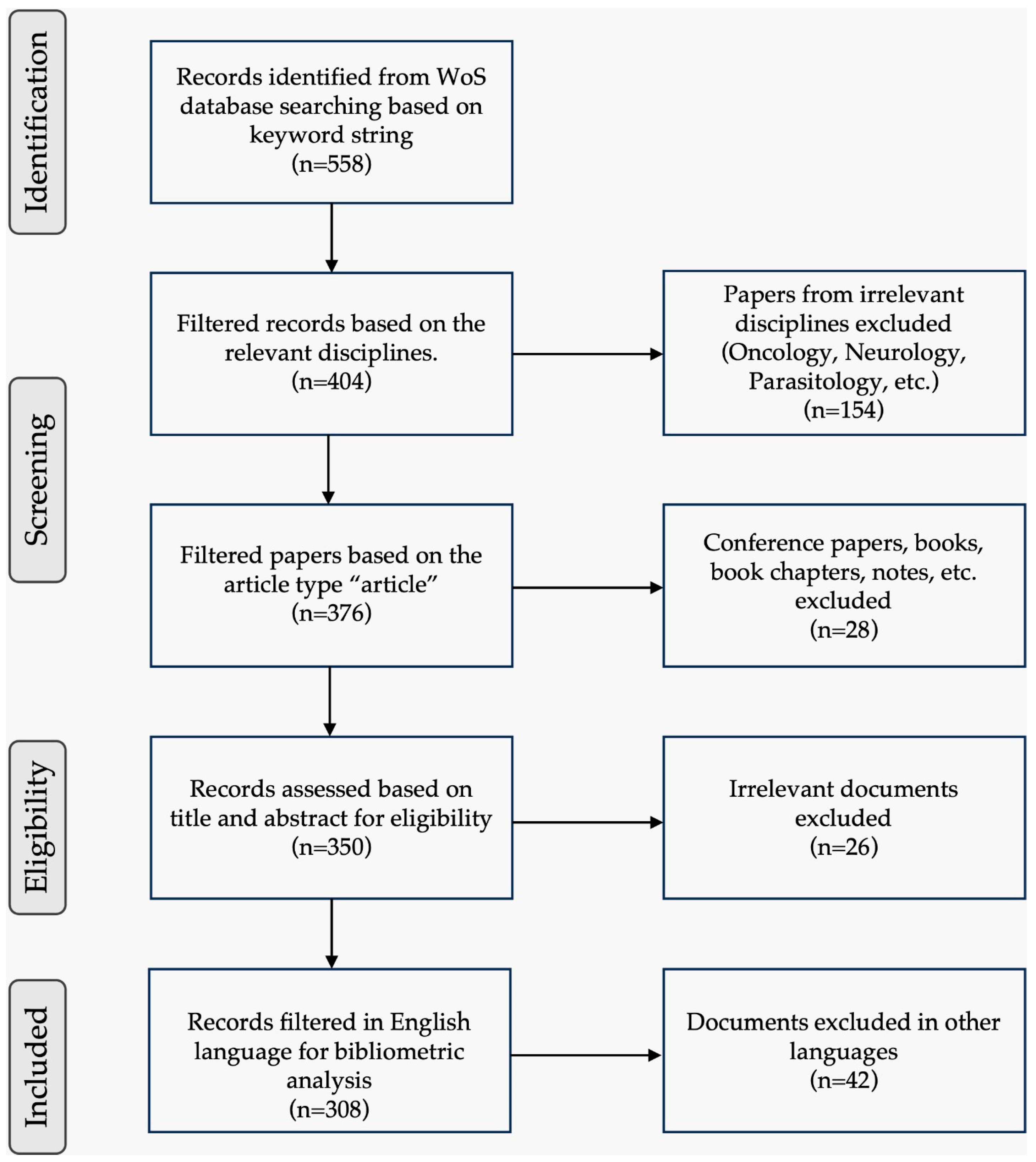
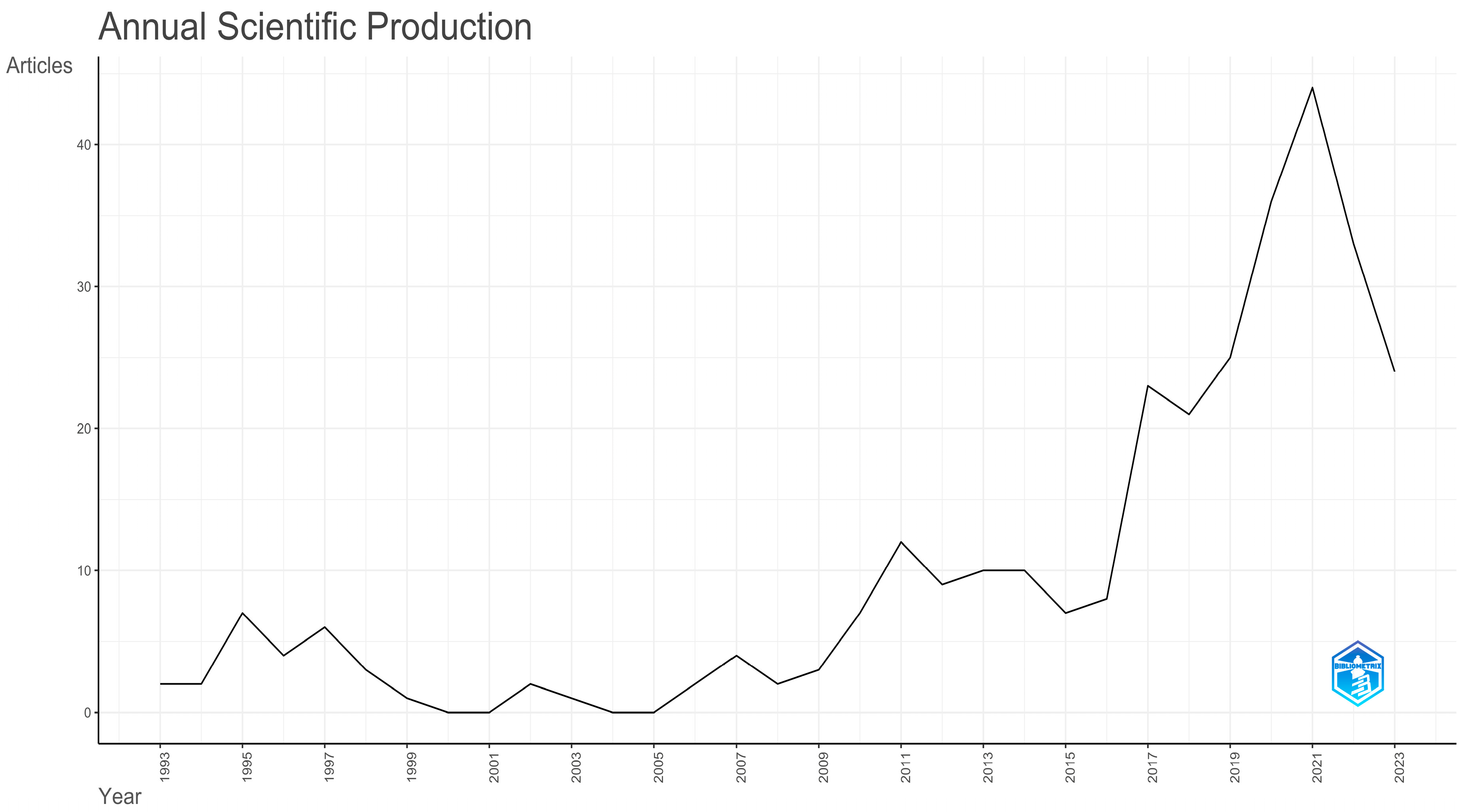
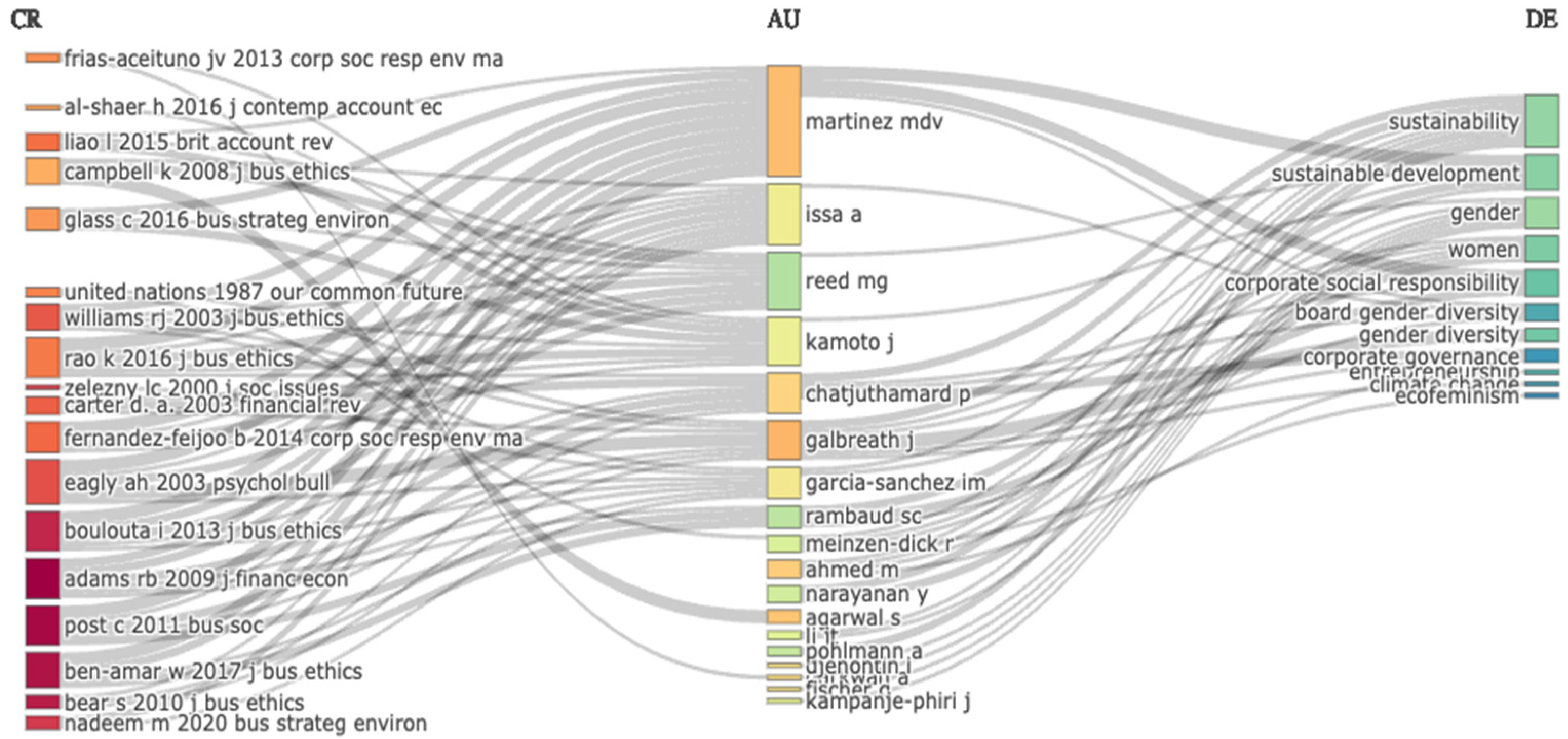
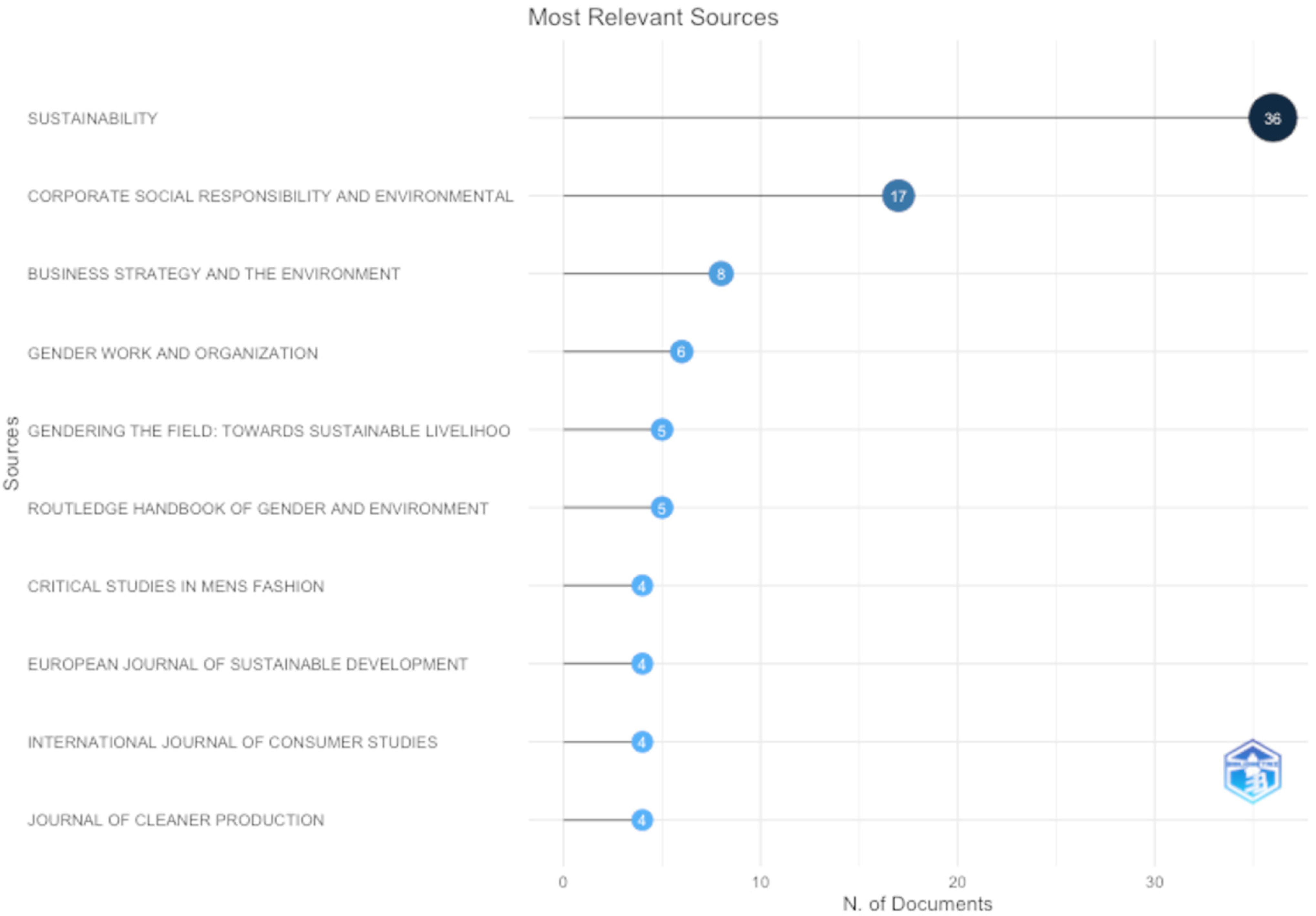
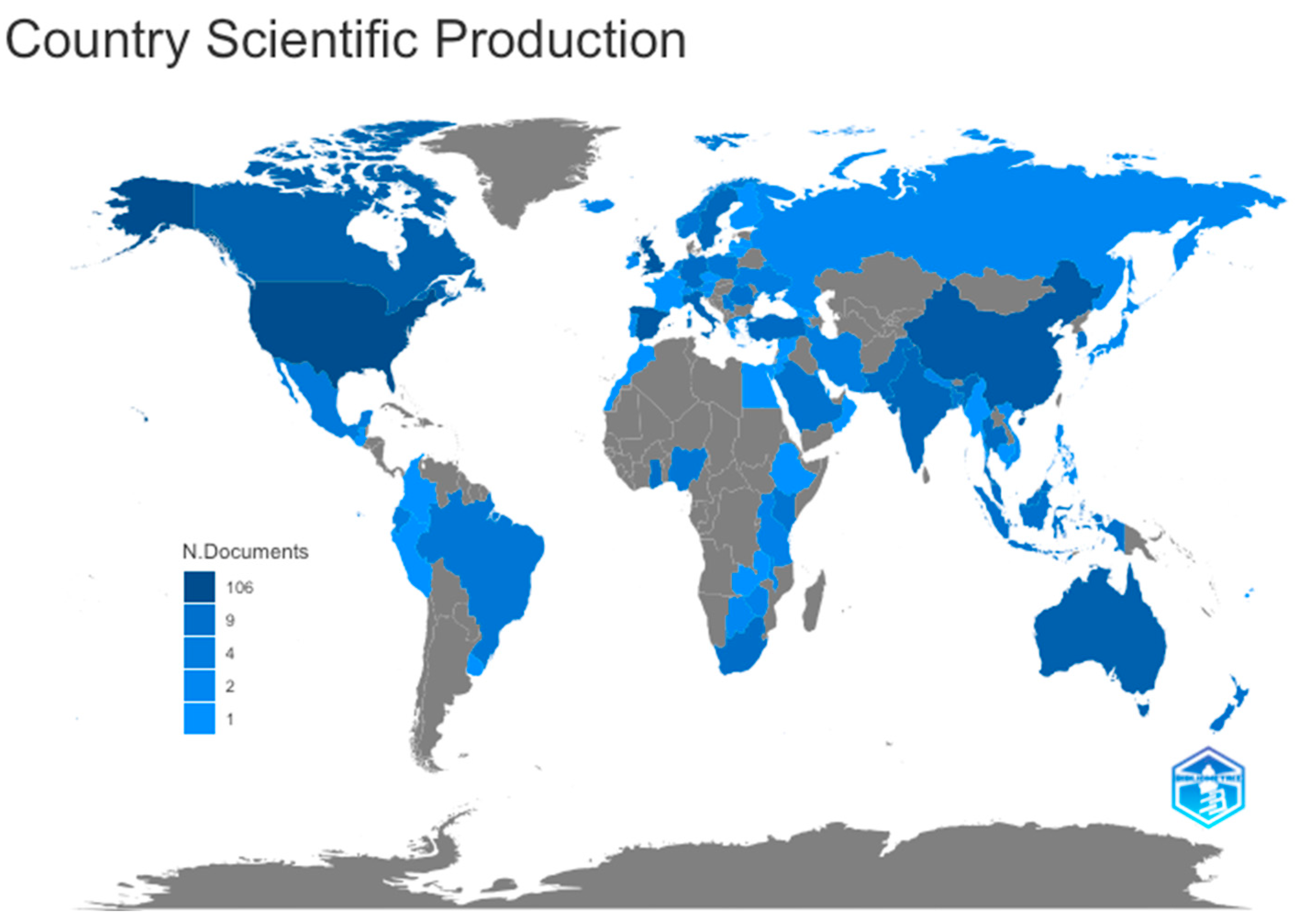
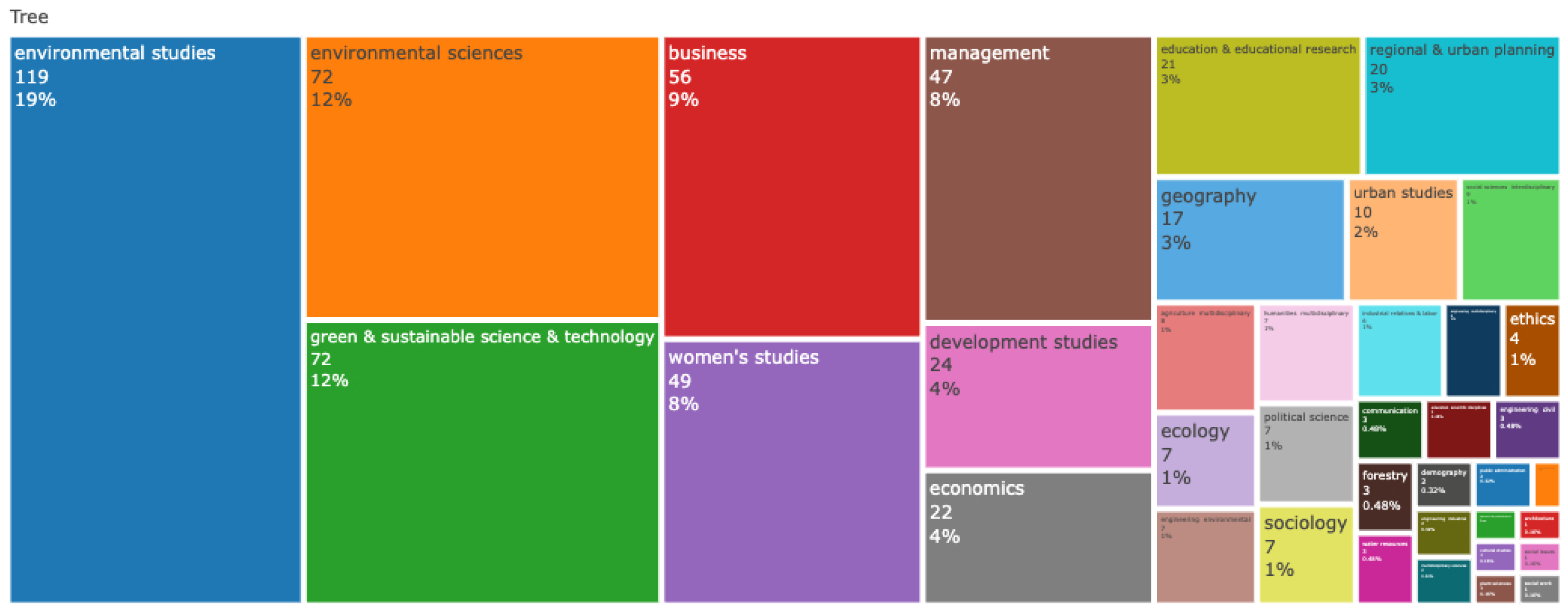
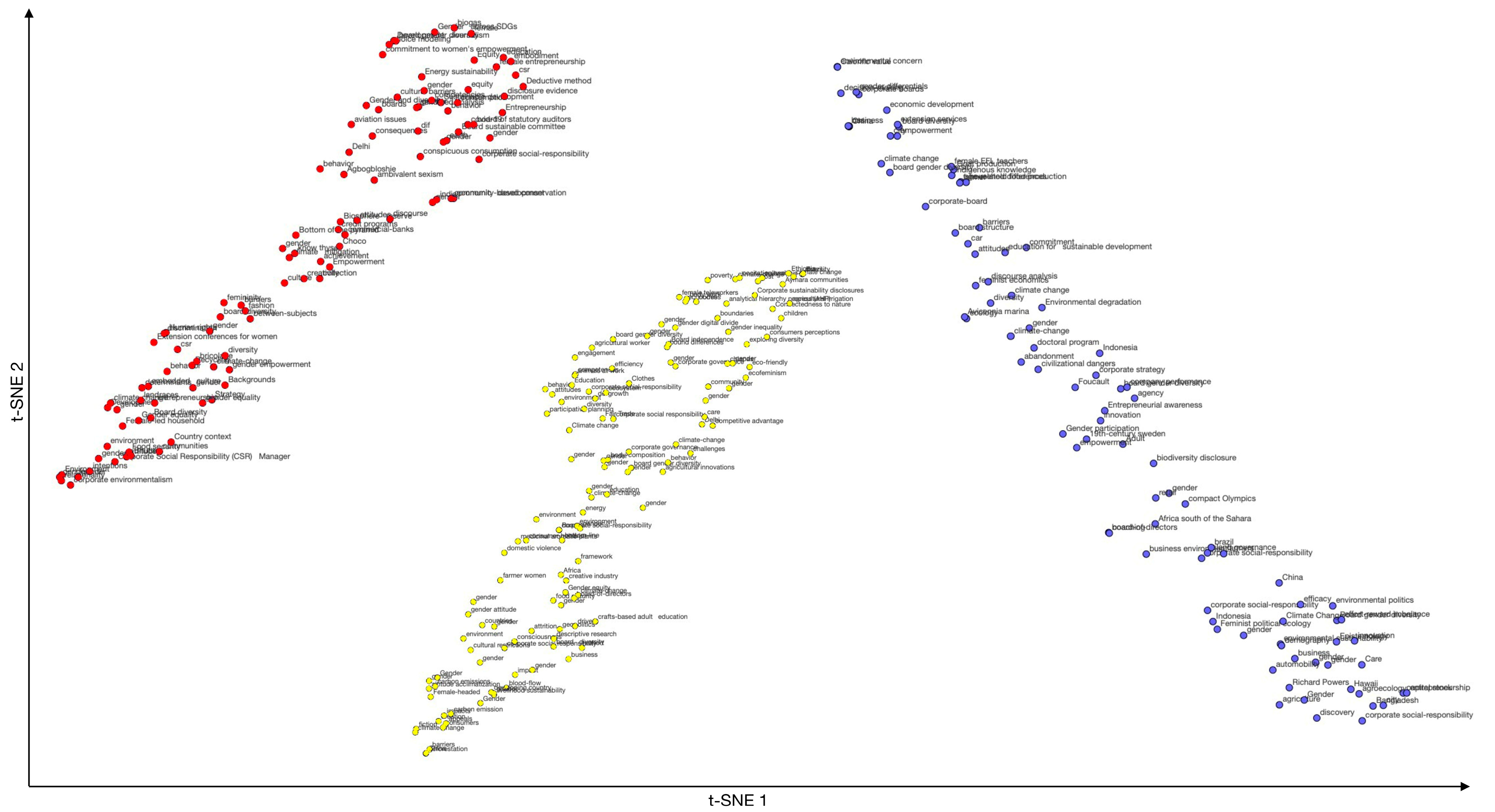
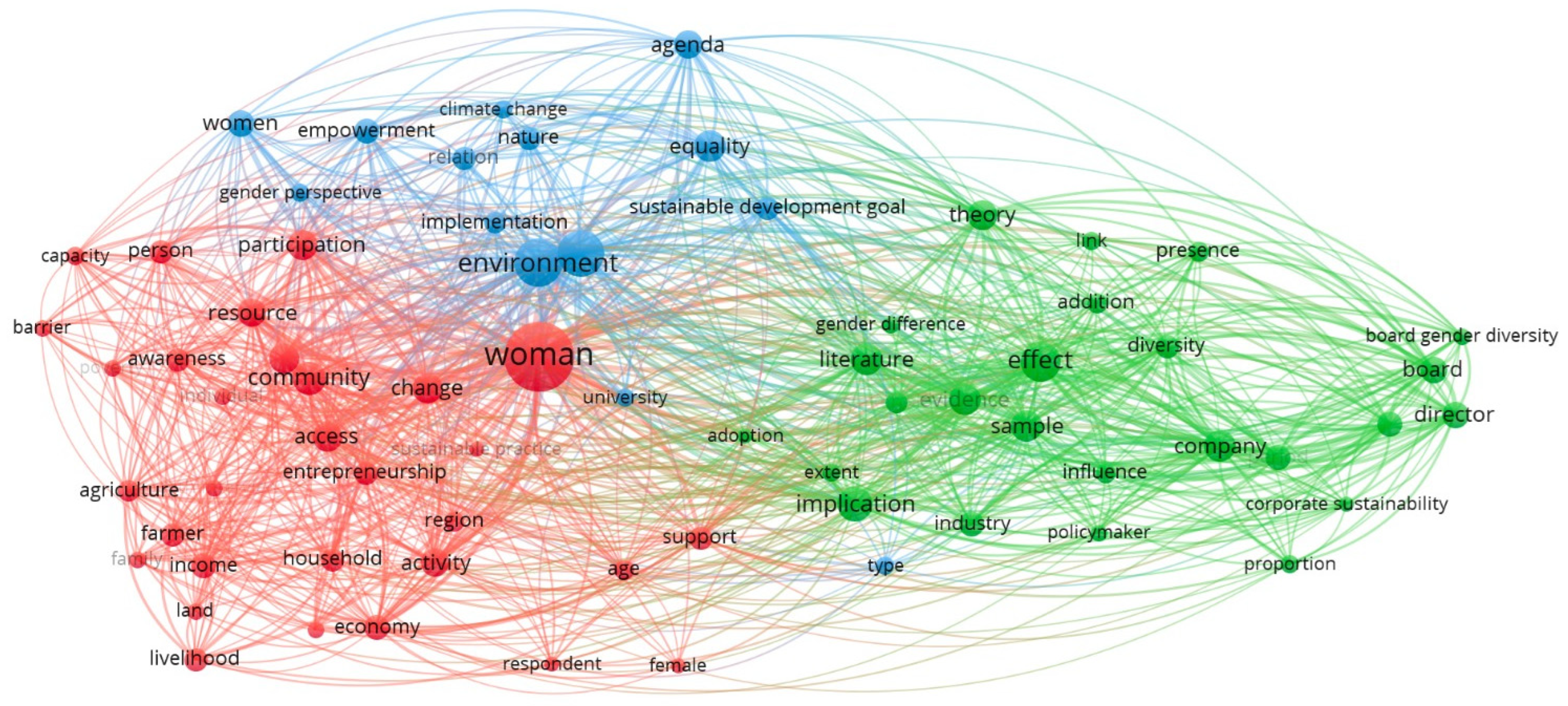
| Research Corpus | |
| Name of Database | Web of Science |
| Search Period | 1993–2023 |
| Search Queries | |
| Queries (Subject Specific) | TITLE (“gender” OR “women” OR “men “OR “female” OR “male”) |
| Boolean Search Parameter | AND |
| Queries (Field Specific) | TITLE (“sustain *”) |
| Boolean Search Parameter | AND |
| Queries (Field Specific) | TITLE (“urban space” OR “urban *” OR “environ *”) |
| Identification | The number of identified documents in Web of Science (n = 558) |
| Screening | Documents from irrelevant fields excluded (n = 154) Document type limited to “article” (n = 404) Non-empirical articles excluded (n = 54) Articles written in other languages than English excluded (n = 42) |
| Included | A total of 308 papers included in the final research corpus |
Disclaimer/Publisher’s Note: The statements, opinions and data contained in all publications are solely those of the individual author(s) and contributor(s) and not of MDPI and/or the editor(s). MDPI and/or the editor(s) disclaim responsibility for any injury to people or property resulting from any ideas, methods, instructions or products referred to in the content. |
© 2023 by the authors. Licensee MDPI, Basel, Switzerland. This article is an open access article distributed under the terms and conditions of the Creative Commons Attribution (CC BY) license (https://creativecommons.org/licenses/by/4.0/).
Share and Cite
Gudekli, A.; Dogan, M.E.; Goru Dogan, T.; Gudekli, D. Gender, Sustainability, and Urbanism: A Systematic Review of Literature and Cross-Cluster Analysis. Sustainability 2023, 15, 14994. https://doi.org/10.3390/su152014994
Gudekli A, Dogan ME, Goru Dogan T, Gudekli D. Gender, Sustainability, and Urbanism: A Systematic Review of Literature and Cross-Cluster Analysis. Sustainability. 2023; 15(20):14994. https://doi.org/10.3390/su152014994
Chicago/Turabian StyleGudekli, Aysad, Murat Ertan Dogan, Tulay Goru Dogan, and Duygu Gudekli. 2023. "Gender, Sustainability, and Urbanism: A Systematic Review of Literature and Cross-Cluster Analysis" Sustainability 15, no. 20: 14994. https://doi.org/10.3390/su152014994
APA StyleGudekli, A., Dogan, M. E., Goru Dogan, T., & Gudekli, D. (2023). Gender, Sustainability, and Urbanism: A Systematic Review of Literature and Cross-Cluster Analysis. Sustainability, 15(20), 14994. https://doi.org/10.3390/su152014994








